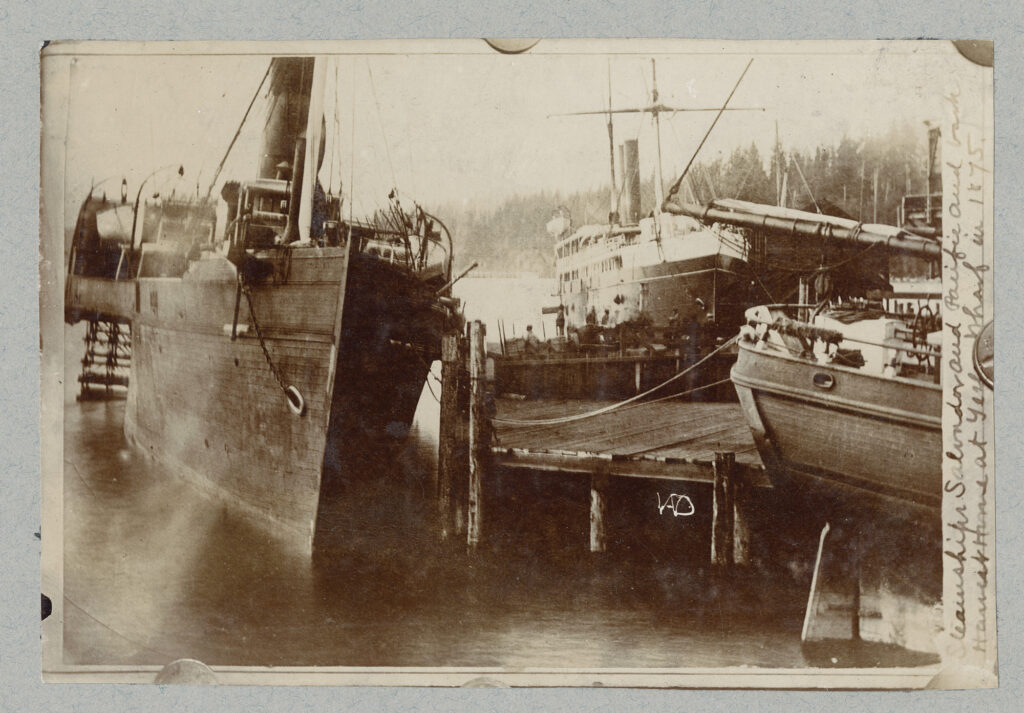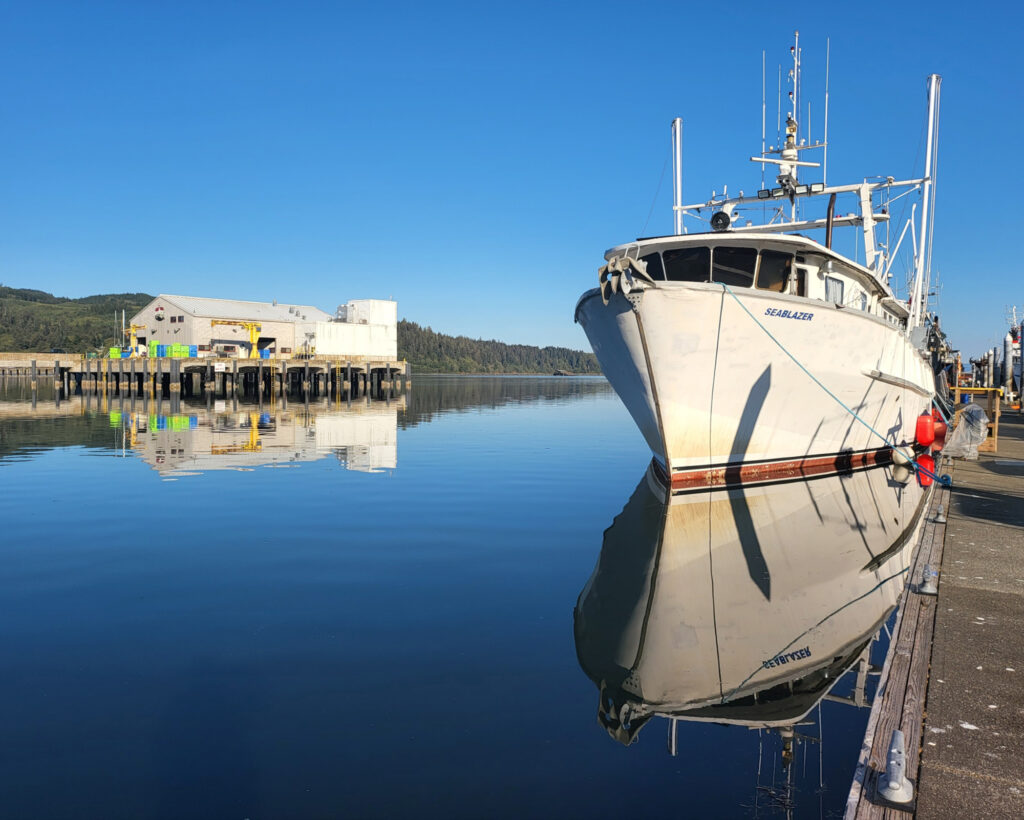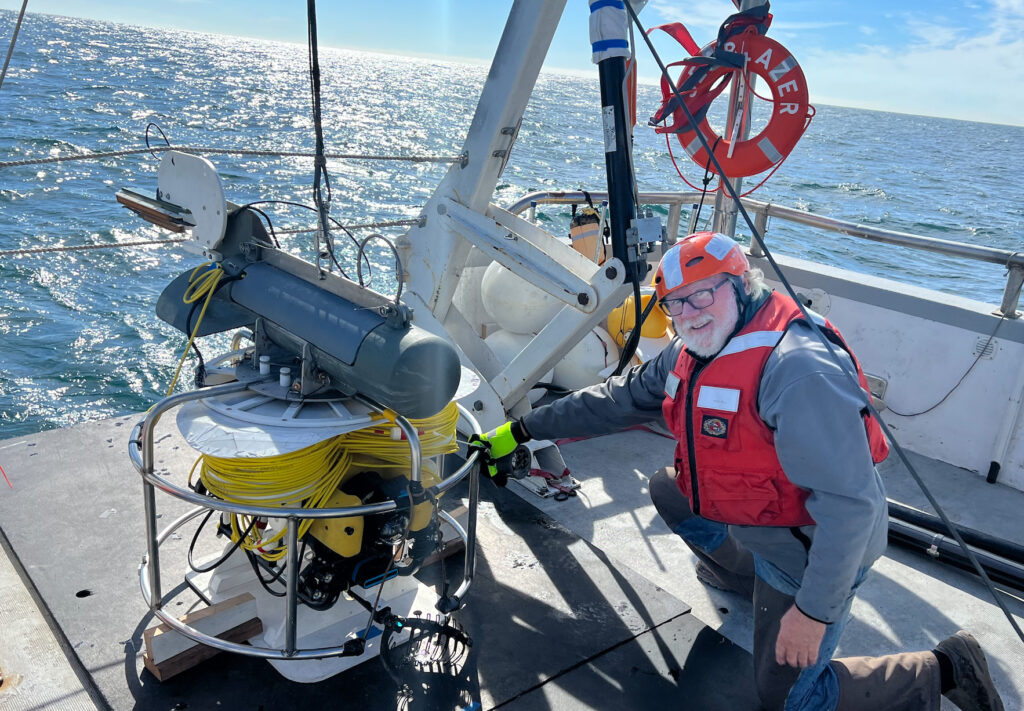
The idea of maritime wreck salvage may conjure up dramatic images of robot submarines floating over the hull of RMS Titanic or maybe even romantic ones of a swashbuckling Indiana Jones-type character swooping in to carry off a precious golden idol. While the story of the 1875 sinking of the SS Pacific does hint at a few of these theatrical Hollywood touches, most of the story involves conducting exhaustive research, listening to working mariners in the area, and developing immense respect for the victims of the worst maritime disaster in Pacific Northwest history.
In December of last year, Jeff Hummel, president of a Seattle-based marine salvage company called Rockfish, Inc., announced that his team had definitively located the remnants of the Pacific, which sank about 40 miles southwest of Cape Flattery, taking the lives of at least 375 people, possibly more. After presenting small artifacts recovered from the wreck, the U.S. Court for the Western District of Washington granted Rockfish exclusive salvage rights.
Since the days immediately after the ship went down, reports from the press focused on a cache of gold that went to the bottom as well. According to maritime records, Pacific was carrying around 200 pounds of recently mined gold, with a value at the time estimated at about $100,000. Converted to 2023 dollars and based on current gold prices, the load may be worth between $7 and $10 million today.
The goal for Hummel, however, is not about money, it’s about honoring history. “One of the things I think is under-reported is the number of people on board,” he said. “There’s a total of 375 known people on board, but there was a really good eyewitness who claimed that there were more like 500 people on board when it departed. Unfortunately, we’ll just never know.”
Some of the passengers were wealthy families and businessmen from Seattle and Canada, but the ship was known to be overloaded with mostly unknown miners who were returning from the Cassiar gold rush that began in 1872 in northern British Columbia. “These were mostly young, male, single people, who didn’t write a lot of letters home, I don’t think,” Hummel mused. “The first-class passengers all had cabins, but there were many people on board who were not on the official manifest. They just paid $5 for the trip and found a spot anywhere they could.”
Even at the low-end estimate of deaths, the SS Pacific disaster remains the single greatest maritime loss of life on the West Coast. For perspective, the population of Seattle was only about 2,000 in 1875. If a loss of similar proportion were to occur today, the death toll would approach 40,000 people.
A Dark and Stormy Night
On the morning November 4, 1875, the SS Pacific left the port of Victoria, B.C., at 9:30 a.m., steaming west towards the mouth of the Strait of Juan de Fuca on its way to San Francisco. The wood-hulled, side-wheel steamship, 223 feet long and 33 feet abeam, made the turn past Tatoosh Island off Cape Flattery at about 4 p.m. and headed south along the coast. As the rainy weather worsened, the steamer made slow progress into the growing headwinds. During the journey, the 25-year-old Pacific had developed a pronounced list to starboard, so its captain, Jefferson Davis Howell, ordered the portside lifeboats to be filled with water to keep the ship on an even keel.
By about 9 p.m., Pacific was about 12 miles off the coast and 40 miles southwest of Cape Flattery as it approached the sailing vessel Orpheus, heading in the opposite direction at about 12 knots with following winds. Pacific had only a masthead light visible in the darkness, which Orpheus’ Captain, Charles A. Sawyer initially mistook for the Cape Flattery lighthouse. When he finally recognized the light was coming from a ship, Sawyer ordered a hard turn to port to avoid a collision. According to Sawyer’s reports, the Pacific did not alter its course or reverse its engines until the ships were just a few feet apart.
Pacific struck a glancing blow off Orpheus’ starboard side, made contact a few more times as the vessels grinded past each other in the swells. The sailing ship lost several feet of rail and some of the starboard rigging, but didn’t suffer any life-threatening damage, so Capt. Sawyer continued north while the 876-ton Pacific continued south, with engines still running.
Aboard Pacific, the atmosphere was much more chaotic. As passengers rushed to the hurricane deck, the overloaded, top-heavy ship lurched heavily to port. While the crew helped the panicked passengers into the ship’s five lifeboats, the ones to port, which were already partly filled with ballast water, immediately foundered, spilling their occupants overboard. The rest of the lifeboats were never lowered in time and also quickly capsized. In perhaps half an hour after the collision, the old side-wheeler slid under the whitecaps.
During the sinking, part of Pacific’s hurricane deck and the wheelhouse tore off the ship and continued to float, providing some refuge for about two dozen people. But as the hours passed, the survivors succumbed, one by one, to exposure or exhaustion. Passing vessels eventually discovered the floating wreckage, which had drifted back into the Strait of Juan de Fuca. Only two people from the Pacific survived after hanging on for nearly three days.
Hitting the Books
Finding one of the most infamous and elusive wrecks in Northwest history took decades for Hummel. After making 17 trips on chartered boats to the area where Rockfish assumed the wreck would be, Hummel purchased a fishing vessel, the R/V SeaBlazer, in 2004 and converted it into a research boat from which the crew could launch the sonar equipment. All told, Rockfish has completed 12 separate Pacific expeditions with the SeaBlazer at a cost of about $2 million that was raised from a list of 45 project donors.
But most of what made the project a success depended not on the equipment at sea but on what information could be found on land. “The first step always starts in the archives,” Hummel said. “Without accurate information, you might as well not even start.”
With very little evidence from the two eyewitness survivors of the disaster, Hummel pored over every news article, nautical report, weather record—any applicable scrap of data he could find. “I tried to reconstruct the accident scenario as if it were a plane crash,” he said.
Using the 1854 sea charts Pacific’s Capt. Howell had used at the time, Hummel recreated the course for the ship, based on the descriptions from Pacific’s surviving quartermaster, Neil Henly. He also found complete records of tidal currents for the area to help calculate the vessel’s exact speed and direction. He then compared these figures to records from every Seattle-to-San Francisco journey the steamer had taken in 1875. The team was even able to pick up on slight differences in the average speed (about a half-knot) between the northbound and southbound legs.
“From all of that data, I was able to dead-reckon the ship to an approximate location where it sank,” he said. With some probability analysis plus “fancy footwork and math,” Hummel had narrowed down the search area to a box measuring about 13 miles by 26 miles. That was progress.
Not his First Underwater Rodeo
Hummel was also able to fall back on salvage experience he’d earned at the tender age of 18, when he first launched an underwater expedition: A search for a rare World War II aircraft, a Curtis SB2C Helldiver torpedo bomber, that had been discarded in Lake Washington in the 1940s. Hummel and a high school friend, Matt McCauley, were able to locate the wreck in the early 1980s and managed to bring it to the surface using reconfigured air hoses and lift balloons.
For his contribution, McCauley purchased a $20,000 side-scan sonar that could be used to find underwater objects remotely from the surface. “We spent hundreds of hours honing our skills with the side scanner,” Hummel recalled. “Eventually, we got so good that we could put a buoy right on top of the little airplane in 150 to 160 feet of water.”
Soon after the plane was recovered, McCauley and Hummel received a notice from the U.S. Navy, saying they wanted their old airplane back. In the ensuing lawsuit against the two teenagers, the Navy argued that it had never lost title to the plane. A few years later, however, a judge in the case ruled that the Navy had abandoned the relic and did not make any attempt to recover it, so pair were awarded the salvage rights at age 21. Over the ensuing years, Hummel said a restoration company had fully reconditioned the Helldiver. The aircraft is now likely to return to flying condition within the next couple of years, he added.
Hummel said he learned a couple vital lessons from the airplane experience: “A) That it’s possible for anyone to go do this. No one’s there to stop you. And B) An appreciation for the legal aspects of these projects. You’ve got to have a good legal footing before you do anything.”
For their next act of underwater salvage, Hummel and McCauley consulted a book called Lewis & Dryden’s Marine History of the Pacific Northwest, published in 1893. “It’s kind of like the Bible of everything maritime in the Northwest area,” Hummel said. In it, the budding salvors discovered the plight of the still-undiscovered SS Pacific. The guide’s author, Edgar Wilson Wright, memorably introduced the disaster thusly: “Long will be remembered the year 1875, when Death, clad in all his hideousness, rode the wave.”
The tragic story of the sunken side-wheeler would become Hummel’s next great adventure for the next 30-plus years.
Trawling for Clues
Narrowing down the search was certainly helpful, but the Rockfish team was only halfway there. The weeks of deploying the side-scan sonar—sweeping back and forth, like cutting an enormous field of grass with a slow, constantly shifting lawnmower—was an expensive, and sometimes tedious, affair.
“The weather is never very cooperative out there,” said Arnie Hammerman, a marine industry expert and member of the Rockfish expedition team. “We drew grid lines electronically on charts and would drag the sonar behind the boat, watching for changes in the current. We were checking data literally for years.”
The search continued through the 2010s, mostly by trial and error, and also with the cooperation of other groups that had been looking for the Pacific for many years. “The general consensus was that you would be able to see things, like a boiler and the steam machinery and the paddle wheels,” Hummel said. “But that turned out to not be true at all.”
There were no true “Eureka!” moments during these years, but the turning point came when Hummel struck up friendships with the other people who regularly cruised the same coastal areas: fishing trawler captains. “If you don’t get to the top of the mountain on your own,” he said, “you’ve got to find another way to get to the top.” Or to the bottom, in this case.
Two commercial fishermen provided Rockfish with invaluable information about how they dragged their nets across the bottom off Cape Flattery and would occasionally pick up odd scraps from the ocean floor. One said he had picked up what looked like coal on the bottom and still had a few of the samples. Hummel had the lumps examined by a chemical expert, who determined that the coal likely came from a mine that could have supplied fuel for the Pacific.
“We overlaid our information with the areas where they been dragging their nets,” he explained. “From that, I was able to eliminate a large portion of our search area. It eventually came down to only a couple of square miles. There were no other options, the wreck had to be in that area.”
The spot where the wreck was eventually found had been searched twice before by two other groups, back in 1993 and again in 2000. “They’d gone right over the wreck and had every opportunity to view it, but it’s so obscure that they didn’t see it,” Hummel said.
“We didn’t realize what we had, either, until we went back and analyzed the data,” Hammerman added.
Upon further review, the sonar images revealed faint circular outlines of the two giant paddlewheels, measuring eight meters across. “The paddlewheels were really an identifying mark that led us to the ship, but they’re easy to miss,” Hummel said. “They only look interesting from one direction. If you’re right on top of them, they don’t look like anything.”
The Rockfish team immediately began making dives over the Pacific with remotely operated vehicles (ROVs), which they designed and built themselves. The ROVs were able to retrieve small items from the wreck, including a charred fire brick that had been part of the ship’s boiler, and a piece of worm-eaten wood from the hull.
Looking for a Nice Pair of Jeans
The exact nature and orientation of the wreck has not yet been released, other than a few low-resolution sonar images. Rockfish plans to launch its 13th expedition with SeaBlazer, its research vessel, to record detailed images of the entire ship before it gets disturbed. Hummel also said he doesn’t want to allow other salvors come snooping around. However, the main reason for the secrecy is that a TV series about the expedition is likely to be completed this year by the BBC and should air sometime in 2024. “Until then, we want to maintain a little bit of mystery,” he said.
To date, Hummel has only revealed that the wreck is resting between 1,000 and 2,000 feet deep and that the hull is relatively intact. He did add that “there’s no evidence that the ship broke in half,” which provides a clue to Pacific’s state of preservation.
As of February, the Rockfish ROVs have spent about 20 hours investigating more than 1.7 million square feet of the wreck site. Hummel will plan a series of three more expeditions to recover cargo from the debris field before exploring the main part of the wreck in 2024 and the following three years. He estimates that Rockfish will need to raise another $6 to $8 million to complete the full salvage.
Hummel said he expects to reveal a wealth of well-preserved, nearly 150-year-old artifacts. For instance, he said there’s a good chance that the ship’s luggage contains the earliest-known pair of Levi’s in existence. “It’s not just some far-fetched idea,” he said. “Levi Strauss jeans came out in 1873, supplying goods targeted mostly for gold miners. It’s possible they’re still there.”
One reason for Hummel’s high expectations is the concentration of inorganic, unconsolidated clay around the wreck. “It’s the best preservative,” he said, “because the particles of the mud are so small that they interrupt oxidation.” The one piece of wood the team uncovered looks surprisingly like wood after being submerged for a century and a half. “I was expecting the wood to be mushy,” he said. “But since there’s no oxygen down there, the wood is just as sound as it was when it went in.”
These hopes fuel Hummel’s ultimate goal of the whole SS Pacific endeavor: The creation of a museum dedicated solely to the Northwest’s maritime heritage. “We’re still in the early stages of the museum concept, but it’s not going to be just about Pacific,” he said. “We don’t really have a proper museum in this area that does justice to the deep maritime heritage of the Puget Sound.”
Rockfish entered into a mutual agreement with the nonprofit Northwest Shipwreck Alliance (NSA) to transfer any cultural artifacts salvaged from the wreck to NSA for inclusion in the museum. “With NSA, the intention is that an alliance of already-existing groups can create a funding model that makes it viable to establish a world-class museum,” Hummel said. “We want it to generate enough income so it can pay for itself.”
He also hopes to find more clues about why the ship went down so quickly. Built in 1850, Pacific was already well past its prime at the time it sank and had even been briefly abandoned before being called up for the Cassiar gold rush. Rumors persist that rotting timbers in the hull were hidden by the owners, which may have contributed to the ship’s destruction. Future dives may finally answer these questions.
“It’s the big unknown,” Hummel added. “That’s the great thing about it—the surprises that you’ll find that you just won’t be expecting.”
>> For more information on the continuing salvage efforts, and on future plans for a maritime history museum, visit: northwestshipwreckalliance.org.

